|
|
Advance in Red-emitting Mn4+-activated Oxyfluoride Phosphors
JI Haipeng, ZHANG Zongtao, XU Jian, TANABE Setsuhisa, CHEN Deliang, XIE Rongjun
2020 Vol. 35 (8): 847–856
 Abstract
Abstract(
2479 )
 HTML
HTML(
290)
 PDF
PDF(7755KB)(
2563
)
The stable and reliable red phosphor with high-photon energy emission (620-650 nm) is critical for the fabrication of the phosphor-converted white light-emitting diode (WLED) with low correlated color temperature and high color rendering index. Mn 4+-activated phosphor is an emerging kind of red-emitting phosphor for WLED. Herein, the energy levels transition and photoluminescence characteristics of the Mn 4+ ion were introduced; then, the preparation, crystal structure and luminescent properties of as-far reported seven kinds of Mn 4+-doped oxyfluoride red phosphors (such as Na2WO2F4:Mn 4+) containing d 0, d 10 or s 0 cations were reviewed. Currently, only in quite rare case of oxyfluoride, Mn 4+ was found to exhibit strong R-line emission, with local coordination remaining as either [MnF6] or [MnO6]. The studies on the chemical stability and quantum efficiency of Mn 4+-doped oxyfluoride phosphors are still insufficient. Finally, we prospected the future development of Mn 4+-doped oxyfluoride phosphor.
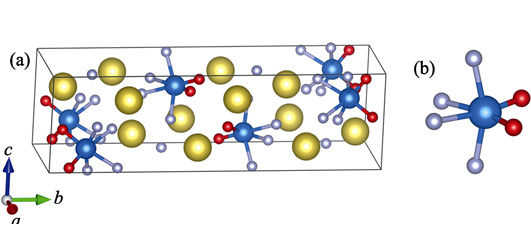
|
|
|
Dynamic Mechanical Analysis in the Investigation on Ferroelectrics
CHEN Yun, WANG Xusheng, LI Yanxia, YAO Xi
2020 Vol. 35 (8): 857–866
 Abstract
Abstract(
1101 )
 HTML
HTML(
37)
 PDF
PDF(6375KB)(
1334
)
Dynamic mechanical analysis (DMA) has the advantage of high sensitivity, excellent cooling system, flexible rotation testing part, multiple deformation mode, and continuous frequency and temperature scanning mode. DMA is able to characterize the strain response under alternating stress, creep, stress relaxation, and thermomechanical properties, which has application in the investigation of plastic, thermoset, composite, high elastomer, coating, alloy and ceramic. This paper briefly introduced the fundamental and method about DMA, the application of DMA in the investigation of ferroelectric-paraelectric phase transformation, low frequency relaxation, ferroelectric fatigue, and ferroelectric composite damping. In the measurement of relaxation behavior of PZT ceramics and single crystals, and BaTiO3 ceramics, DMA tended to be more sensitive than dielectric characterization especially in the low frequency range. DMA has been one of the critical instruments for ferroelecric investigation.
|
|
|
Research Progress on Functional Modifications and Applications of Bioceramic Scaffolds
DONG Shaojie,WANG Xudong,SHEN Steve Guofang,WANG Xiaohong,LIN Kaili
2020 Vol. 35 (8): 867–881
 Abstract
Abstract(
851 )
 HTML
HTML(
35)
 PDF
PDF(26668KB)(
1325
)
Porous bioceramic scaffolds, which possess attractive biocompatibility, ability to guide tissue regeneration and porous surface morphologies and channels beneficial to ingrowth of new born tissues, have seized increasing attentions and been widely applied in the field of hard tissue restoration. Whereas, the weak osteoinductive activity, monotonous biological function and poor mechanical property have restrained the therapeutic efficacy and wider application of bioceramic scaffolds. In view of this, we intended to introduce the existing modification methods of bioceramic scaffolds, including the surface modification with functional coating, construction of surface micro-/nano- structures, functional element doping and enhancement of mechanical property, along with the state of the research progresses in the improvement of biocompatibility, bone defect restoration, drug delivery, tumor therapy, and antibacterial capacity of multifunctional bioceramic scaffolds. In addition, potential research directions and applications of functionally modified bioceramic scaffolds are prospected to provide references for the related exploration afterwards.
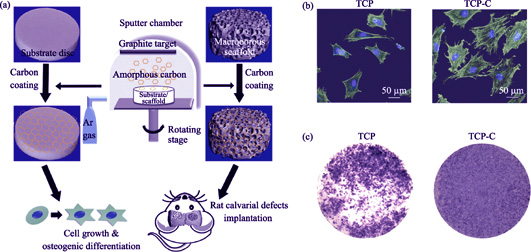
|
|
|
Stable Li-metal Depositon on Lithiophilic 3D CuO Nanosheet-decorated Cu Mesh
LI Rui,WANG Hao,FU Qiang,TIAN Ziyu,WANG Jianxu,MA Xiaojian,YANG Jian,QIAN Yitai
2020 Vol. 35 (8): 882–888
 Abstract
Abstract(
1238 )
 HTML
HTML(
74)
 PDF
PDF(7761KB)(
1313
)
Lithium metal anode, due to its highest theoretical specific capacity (3860 mAh·g -1) and lowest electrochemical potential (-3.04 V (vs SHE)), has become the first choice of the next generation of electrochemical energy storage devices. It is known as the “holy grail” of the battery industry. However, the disadvantage of lithium metal battery is particularly obvious: during the charge and discharge process, lithium metal battery is easy to deposit unevenly on the anode electrode, resulting in lithium dendrite which causes the continuous rupture and formation of solid electrolyte interface (SEI) film. The unstable SEI film, intensifying the formation of lithium dendrites and then piercing the separator, causes a decline for the battery cycle performance and the safety hazard. Therefore, it is particularly important to take corresponding measures to make lithium metal uniformly deposited on the anode. In this study, the uniform lithiophilic copper oxide nanosheet array formed on the surface of commercial copper mesh through oxidation of alkaline solvent and calcination of air. The 3D structure of copper mesh can effectively reduce the current density, and the lithiophilic nanosheet array can effectively reduce the overpotential of lithium deposition simultaneously. This lithiophilic 3D copper-based current collector makes lithium deposited uniformly and effectively, and inhibits the formation of lithium dendrites. In the half-cell test at a current density of 3 mA·cm -2 the battery circulated stably for 230 cycles with Coulombic efficiency remaining above 99%. The lithium iron phosphate (LFP) full battery with the as-prepared material as current collector worked stably for more than 300 cycles at 1C(0.17 mA·mg -1) and present a capacity retention of ~95%. This study provides a new design strategy of 3D current collector for stable lithium metal batteries.
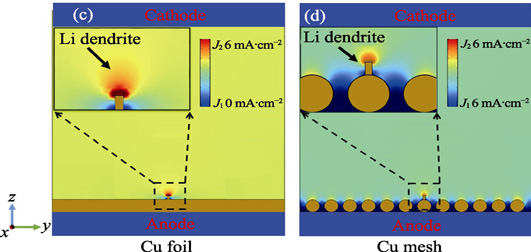
|
|
|
Molecular Dynamics Analysis of Chemical Disorders Induced by Irradiated Point Defects in 6H-SiC
ZHANG Xiuyu,CHEN Xiaofei,WANG Hao,GUO Xun,XUE Jianming
2020 Vol. 35 (8): 889–894
 Abstract
Abstract(
568 )
 HTML
HTML(
12)
 PDF
PDF(809KB)(
837
)
To cooperate with studying the influence of chemical disorder on the conductivity of 6H-SiC, the linear collision cascade of 6H-SiC was simulated by the classical molecular dynamics with LAMMPS. Evolution process of main point defects in 6H-SiC during single linear cascade collision and multiple linear cascade collisions under different energy and different types of PKA (Primary Knock-on Atom) is given, while chemical disorder and the final proportion of each of the point defects are counted. The results show that the Si-Si bond generated by the linear cascade collision is easier to form and more stable than the C-C bond. The Si-Si bond is mainly formed by the antisite defect SiC, the C-C bond is mainly formed by the C-interstitial cluster. Their chemical disorder and point defect yield are affected by the type and initial energy of PKA. However, the proportion of each point defect is almost unchanged.
|
|
|
Crystal Structures, Optical, and Magnetic Properties of Zn3-xMnxTeO6
LI Shufang,ZHAO Shuang,ZHOU Xiao,LI Manrong
2020 Vol. 35 (8): 895–901
 Abstract
Abstract(
523 )
 HTML
HTML(
23)
 PDF
PDF(5598KB)(
759
)
The effects of Mn 2+ doping on the structural, optical and magnetic properties of the corundum-related oxide Zn3TeO6 were investigated. Polycrystalline ceramic samples of the solid solution Zn3-xMnxTeO6 (0<x≤2.0) were prepared by a solid-state reaction route. Phase diagram as a function of Mn concentration indicates monoclinic (C2/c) structure for x<1.0, disproportionated mixing of both monoclinic (C2/c) and rhombohedral (R-3) structure for 1.0≤x≤1.6, and R-3 structure for x≥1.8. Moreover, when x=2.0, ZnMn2TeO6 was formed, in which the bond length of Te-O and Mn/Zn-O increased, and the Mn/ZnO6 octahedra became more distorted. Rietveld refinements of the crystal structures from the powder X-ray diffraction (XRD) data showed that the Zn/MnO6 octahedra were highly distorted in R-3 phase. With the increase of Mn 2+ doping content, the solid solution Zn3-xMnxTeO6 demonstrated not only the structure change from C2/c to R-3, but also the color evolution from light yellow to dark yellow. In optical absorption spectroscopy, with the increase of Mn 2+ doping concentration, the absorption at 400-550 nm was enhanced, and the optical band gap of the samples gradually decreased from 3.25 eV (x=0.1) to 2.08 eV (x=2.0). Analysis revealed that the color of samples changed from light yellow to dark yellow is due to the d-d transition of Mn 2+ ions in Zn/MnO6 octahedron. Magnetic measurements indicate that the antiferromagnetic transition temperature of the solid solution gradually increased with the increase of the doping amount of Mn 2+, and the doped Mn 2+ ions exist in a high spin state.
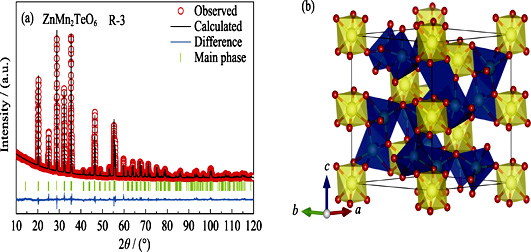
|
|
|
Upconversion Luminescence and Temperature Sensing Properties of Layered BiOCl: Er3+ under 1550 nm Excitation
PENG Yuehong,REN Weizhou,QIU Jianbei,HAN Jin,YANG Zhengwen,SONG Zhiguo
2020 Vol. 35 (8): 902–908
 Abstract
Abstract(
576 )
 HTML
HTML(
17)
 PDF
PDF(2618KB)(
853
)
The sensitivity of optical temperature sensing based on the conventional rare-earth ion doped upconversion (UC) materials is limited by the energy gap between thermally coupled levels (TCLs) of rare-earth ions. Therefore, it is of great theoretical and technical interest to explore UC luminescent materials for optical temperature sensing with ultra-sensitive temperature characteristic. In this work, the UC luminescence properties and temperature sensing characteristics were studied for Er 3+ single-doped BiOCl excited by 1550 nm laser. Under near-infrared (NIR) excitation, BiOCl:Er 3+ exhibits strong red emission at 670 nm, weak green emissions at 525 and 542 nm, extremely weak violet emission at 406 nm, and near-infrared emission at 983 nm. Red and green emissions of the UC system exhibit strong temperature dependence, and in the temperature range of 300-563 K, the maximum absolute sensitivity (SA) obtained by employing the non-thermally coupled levels (NTCLs, 4F9/2/ 4S3/2) is 95.3×10 -3K -1, which is 21 times more than that obtained by employing the thermally coupled levels (TCLs, 2H11/2/ 4S3/2), and the maximum relative sensitivity (SR) is as high as 1.19% K -1. The results show that the intense red UC luminescence and temperature sensing with ultra-high sensitivity in BiOCl:Er 3+ under 1550 nm excitation may have potential application prospect in display and optical temperature sensing.
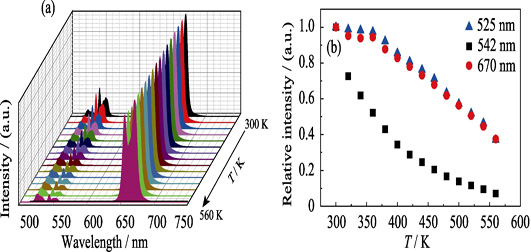
|
|
|
A Quasi-gel SiO2/Sodium Alginate (SA) Composite Electrolyte for Long-life Zinc-manganese Aqueous Batteries
LI Xueyuan,WANG Honggang,TIAN Zhu,ZHU Jianhui,LIU Ying,JIA Lan,YOU Dongjiang,LI Xiangming,KANG Litao
2020 Vol. 35 (8): 909–915
 Abstract
Abstract(
1275 )
 HTML
HTML(
52)
 PDF
PDF(8172KB)(
1602
)
Zinc-manganese (Zn/MnO2) batteries with outstanding advantages of high operation safety, high environmental benignity and high cost performance, is suitable for the application of large-scale energy storage battery. However, the uncontrolled growth of zinc dendrites on the metal zinc anode during charge-discharge cycling causes serious problems such as quick capacity decrease and short circuit failure. In this study, the aqueous electrolyte was converted into a composite quasi-gel electrolyte by adding hydrophilic nano-silica (SiO2) and sodium alginate (SA), which effectively inhibits the dendrite growth of the surface of the zinc negative electrode and the capacity degradation of the Zn-MnO2 battery. Galvanostatic charge-discharge tests showed that the Zn/MnO2 battery with composite gel electrolyte achieves a capacity retention of 78% after 1800 cycles, while the capacity of Zn/MnO2 battery using ordinary electrolyte almost fails after 1000 cycles. The three-dimensional network structure of the gel electrolyte can improve the distribution uniformity of zinc ion in electrolyte, reduce the capacity decay rate and failure risk of the batteries.
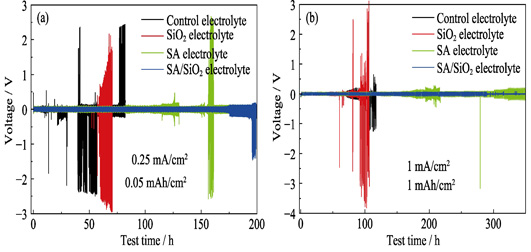
|
|
|
Influence of Ge1-xInxTe Microstructure on Thermoelectric Properties
QIU Xiaoxiao,ZHOU Xiying,FU Yuntian,SUN Xiaomeng,WANG Lianjun,JIANG Wan
2020 Vol. 35 (8): 916–922
 Abstract
Abstract(
505 )
 HTML
HTML(
21)
 PDF
PDF(8909KB)(
847
)
The resonant levels can be introduced into GeTe by In element, however, the effect of its microstructure on thermoelectric properties still remained unclear. In this study, a series of Ge1-xInxTe samples were prepared by smelting-quenching-annealing combined with spark plasma sintering (SPS). The XRD, SEM, laser thermal conductivity instrument and thermoelectric performance analysis system (ZEM-3) were applied to study the microstructure and thermoelectric properties. Results show that, with the incorporation of In content, the unit cell volume decreases, and Herringbone structure has become smaller and grain boundaries increase, which result in a decrease in the lattice thermal conductivity. Thereby, a minimum thermal conductivity of 2.16 W·m -1·K -1 is obtained. Meanwhile, In doping introduces the resonant levels and decreases the carrier concentration, so the Seebeck coefficient and the power factor increase. Consequently, the maximum ZT value of 1.15 is obtained in the 0.03 sample at 600 K, which is 26.4% higher than that of GeTe. This indicates that the thermoelectric properties of Ge1-xInxTe can be effectively improved by the microstructure regulation.
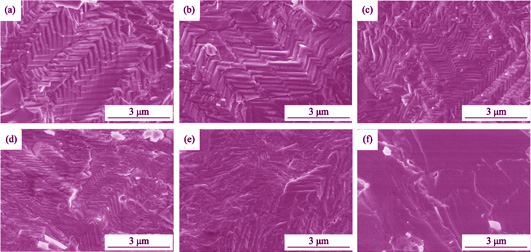
|
|
|
Preparation and Visible-light Photocatalytic Degradation on Metronidazole of Zn2SiO4-ZnO-biochar Composites
ZHANG Dongshuo,CAI Hao,GAO Kaiyin,MA Zichuan
2020 Vol. 35 (8): 923–930
 Abstract
Abstract(
688 )
 HTML
HTML(
28)
 PDF
PDF(4061KB)(
982
)
Using pine alkali hydrolysate to replace NaOH solution as zinc salt precipitator, the Zn2SiO4-ZnO-biochar (SOB-x-y, x is the dosage of pine powder, while y is the concentration of NaOH) ternary composites were prepared by hydrothermal method. The photocatalysts were characterized by different methods. The degradation of metronidazole over the H2O2 photocatalysis was studied. Results showed that the as-prepared photocatalysts were composed of jujube-type willemite Zn2SiO4 mesocrystals, hexagonal ZnO and pine biochar. Compared with pure hexagonal ZnO, the SOB-x-y photocatalysts has better H2O2 photocatalytic activity due to the higher surface area and pore volume, lower band gap energy, lower PL emission peak intensity. Metronidazole degradation using the H2O2 photocatalysis was well-fitted to a pseudo-first-order kinetic model by SOB-x-y. Its catalytic activity increased with the increase of NaOH concentration, and increased at first and then decreased with the increase of pine flour content. The SOB-3-4 has best photocatalytic acitivity. Meanwhile, rate constant (k) and degradation rate (η) of SOB-3-4 increase with the decrease of pH, increase with the increase of H2O2 concentration, increase firstly and then decrease with the increase of catalyst dosage. Degradation rate of metronidazole gradually decreases with the increase of its initial concentration. Under the optimal condition (pH=3, catalyst dosage of 0.4 g/L, H2O2 dosage of 80 mmol/L, initial metronidazole concentration of 300 mg/L), k value was 2.68×10 -2 min -1 and η reached 99.70% after reaction for 3 h. This study provides an important experimental basis for the treatment of pharmaceutical wastewater.
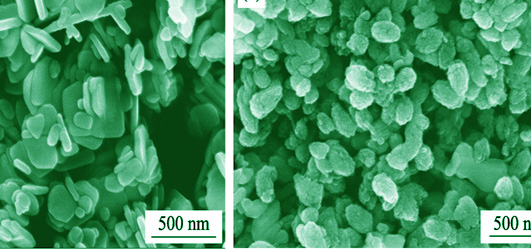
|
|
|
Effect of High Temperature Heat Treatment on Phase Composition and Microstructure of SiBCN/HfC Ceramic Composites
WEI Yuquan,YANG Yong,LIU Meng,LI Qile,HUANG Zhengren
2020 Vol. 35 (8): 931–938
 Abstract
Abstract(
578 )
 HTML
HTML(
25)
 PDF
PDF(22085KB)(
1149
)
Amorphous SiBCN powders were prepared by high-energy ball milling-mechanical alloying method. The SiBCN/HfC ceramic composites were consolidated by spark plasma sintering (SPS). The influence of high temperature heat treatment on the microstructural evolution and phase composition was investigated. The results showed that the oxygen was introduced during the mechanical alloying process, leading to the oxidation of BN to form B2O3. HfO2 was formed in the sintering process result from HfC oxydation and reduced to HfB2 by carbothermal reduction reaction after heat-treatment at 1600 ℃ for 1 h. Both HfO2 and HfC were reduced to HfB2 during the heat-treatment at 1650 ℃ and 1800 ℃ by reaction of HfC + C + B2O3 → HfB2 + CO. Introduction of oxygen causes phase transformation of the SiBCN/HfC ceramic composites after heat treatment at high temperatures, during which ceramic matrix becomes loose and porous due to volatilization of the gaseous byproducts. Therefore, control of oxygen content is the key to the real applications of SiBCN/HfC ceramic composites at high temperatures.
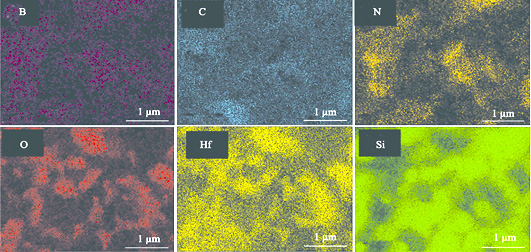
|
|
|
High Performance a&b Oriented T Zeolite Membrane by a Two-stage Crystallization Synthesis
ZHANG Bo,ZHANG Ning,YANG Jianhua,LAN Jiancheng,WANG Jinqu
2020 Vol. 35 (8): 939–946
 Abstract
Abstract(
587 )
 HTML
HTML(
12)
 PDF
PDF(2907KB)(
778
)
A thin and dense high-performance T-type zeolite membrane was successfully prepared by a two-step seed crystal induction plus two-step temperature-varied hydrothermal synthesis on inexpensive and macroporous α-Al2O3 support. This method can fully perform nucleation of seed crystal, regulate the epitaxial growth and crystal growth direction by changing the hydrothermal crystallization temperature and time during the two-stage. Finally a continuous and defect-free a&b oriented zeolite T membrane was obtained. Effects of crystallization temperature and crystallization time of the first-stage and crystallization temperature of the second-stage on the surface structure and properties of zeolite membranes were investigated. The T-type zeolite membrane prepared under the optimal two-step crystallization condition displayed high pervaporation performance with flux over 3.84 kg·m -2·h -1 and separation factor higher than 10000 for separation of 90wt% isopropanol/water at 75 ℃.
|
|
|
Microstructure and Property of Thermal Insulation Coating on the Carbon Fiber Reinforced Epoxy Resin Composites
PAN Bichen,REN Penghe,ZHOU Tejun,CAI Zhenyang,ZHAO Xiaojun,ZHOU Hongming,XIAO Lairong
2020 Vol. 35 (8): 947–952
 Abstract
Abstract(
831 )
 HTML
HTML(
23)
 PDF
PDF(1412KB)(
966
)
A lightweight, environmentally-friendly thermal insulation coating was experimentally applied to the carbon fiber to reinforce epoxy resin composites. The coating is mainly composed of bonding layer, barrier layer and reflective layer, and prepared by using titanium dioxide, silica, aluminum oxide and hollow glass microspheres as function fillers. The addition of waterborne polyurethane with a thermal expansion coefficient of 120×10 -6 K -1 as a film-forming material, is to solve the problem of cracking caused by the mismatch of the thermal expansion coefficients of the coating and the substrate material. The results show that after being applied the coating, can solidify within 24 h at room temperature. When the thicknesses of the bonding layer, the heat barrier layer and the reflective layer were 80, 120, and 90 μm, the thermal insulation coating has the best performance with reflectance of the coating higher than 0.95, the thermal conductivity at 0.048 W·m -1·K -1 and the temperature difference as high as 20.1 ℃. After being subjected to thermal shock at 190 ℃ for 6 times, and the maximum weight loss rate of the coating was 3.7%, indicating the coating highly stable. When kept at 160 ℃ for 4 h, its surface turned yellow without falling off, and its nano filler particles still remained stable.
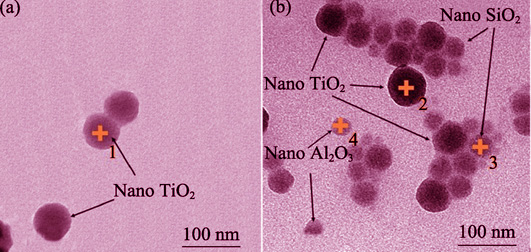
|
|
|
Durability of Fe-N/C Catalysts with Different Nanostructures for Electrochemical Oxygen Reduction in Alkaline Solution
DING Sheng, NING Kai, YUAN Binxia, PAN Weiguo, YIN Shibin, LIU Jianfeng
2020 Vol. 35 (8): 953–958
 Abstract
Abstract(
793 )
 HTML
HTML(
21)
 PDF
PDF(2222KB)(
929
)
The mechanism of Fe-N/C catalysts in oxygen reduction reactions is critical to the development of efficient, sustainable non-noble metal catalysts in polymer electrolyte membrane fuel cells, but it is still in controversy. In order to understand the relationship between composition and the nanostructure of material and the electrochemical activity, this study developed a type of Fe-N/C catalyst with high electrochemical activity, which contained Fe-Nx active sites and Fe/Fe3C nanocrystals encapsulated with nitrogen-doped carbon nanotubes. Despite being free of precious metals, the as-prepared catalyst displays high oxygen reduction reactions (ORR) activity in alkaline medium with the half-wave potential of 0.86 V(vs RHE), the mass activity of 18.84 A/g at 0.77 V(vs RHE), and the maximum current density of -4.3 mA·cm -2. Meanwhile, the electron transfer number is 3.7 at 0.2 V(vs RHE), revealing that the 4-electron ORR reaction exists in the catalyst. The excellent electrochemical activity is attributed to the graphene-encapsulated metallic Fe/Fe3C nanocrystals which improves the conductivity after the growth of N-doped carbon nanotubes, and the relatively high proportion of Fe-Nx active sites distributed on the surface of Fe/Fe3C nanoparticles. This study provides a certain reference and basis for the further study of non-noble metal catalyst and their wide application in commercial production.
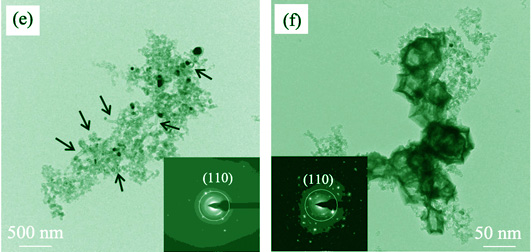
|
|